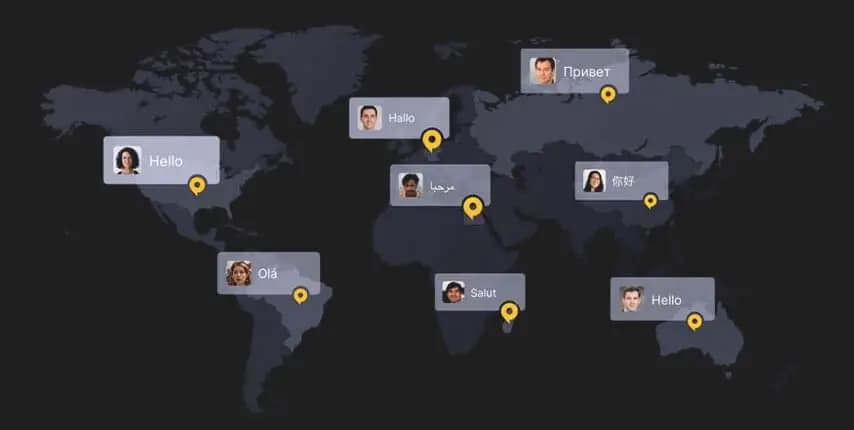Mastering Software Localization: A Deep Dive into Seamless Global Market Expansion with Inspiring Case Studies
Software localization represents a challenging yet essential aspect of globalization. Each piece of software may be used by a variety of users from across the world, and they may be using the same piece of software for a variety of reasons and in hundreds of different ways.
Software localization into another language can benefit organizations looking to expand their products/services into a new market, as well as individuals who want to use platform in their native language. Nowadays, every software product has its own unique set of needs and expectations. This is an important part to comprehend whenever software localization services intersect with your requirements. When you publish an application on a global scale, you want to implement software localization. This is necessary so that you can provide your customers with genuine and accurate information.
To appeal to a local audience, there is a long list and process of software localization that you need to go through to make your system appealing to a global audience. Your program should be as localized as feasible. Market it as if you were a local. Set your pricing strategies as a local. Take into account the needs of your local customers. Apply your new features and updates to audiences all over the world.
The Main 6 Concepts of Software Localization
Considering the expanding software market extending well beyond English-speaking regions, ensuring that software is accessible to a global audience is imperative. Achieving this requires a foundational approach to software development that prioritizes globalization.
The subsequent segments offer general insights into the principles of globalization, localizability, and software localization:
What are the Most Important Aspects of Software Localization?
1. UI or User Interface Localization: you will be elevating your software’s global appeal through software localization services, a process that extends beyond mere translation. You will be turning software product user interface into the richness of the target language by seamlessly translating menu labels, buttons, dialog boxes, error messages, and all user-facing elements. The meticulous approach ensures that every textual and graphical component is thoughtfully adapted, creating a user-friendly experience that transcends linguistic barriers.
2. Documentation Localization: Engaging in software localization encompasses the translation of various elements, including user manuals, help files, online documentation, and other technical content intricately linked with the software. The significance lies not only in linguistic adaptation but also in crafting clear and precise documentation. Ensuring that these materials are easily comprehensible is paramount for users to navigate and utilize the software effectively. In the realm of software localization, the focus extends beyond mere translation, emphasizing the creation of documentation that serves as a user-friendly guide, facilitating a seamless understanding and utilization of the software.
3. Audio and Video Localization: When dealing with applications featuring audio or video content like multimedia applications or video games, the process extends beyond mere software translation. Comprehensive software localization in this context entails the translation of spoken dialogue, subtitles, voiceovers, and other intricate audiovisual elements. It aims not only to convey linguistic nuances accurately but also to ensure a seamless and culturally resonant experience for users engaging with multimedia content. Our approach to software localization in such instances is geared towards providing a fully immersive and localized audiovisual encounter, enhancing the global accessibility and user engagement of your software.
4. Date, Time, Number and Currency Localization: The consideration of diverse date and time formats across regions is important. Software localization involves tailoring the display of dates, times, and calendars to align with the familiar formats of the target audience. Similarly, numerical representations and currencies vary across different regions, emphasizing the importance of adapting the software to display numbers and currency values in accordance with local conventions. Software localization ensures that these subtle, yet crucial elements are seamlessly integrated, promoting user comprehension and creating an interface that feels both intuitive and culturally attuned.
5. Localization Testing and Quality Assurance: In the process of software localization, every localized version undergoes rigorous testing to guarantee the flawless functionality of all elements, ensuring a user experience that is both consistent and intuitive. This meticulous testing phase is integral to our commitment to delivering software that not only meets linguistic requirements but also maintains a seamless and user-friendly interface across diverse regions. Our testing protocols aim to identify and rectify any potential issues, ensuring that each localized version stands up to the highest standards of performance and usability.
6. Time Zone Localization: Consideration of time zones becomes paramount in software designed for scheduling, reminders, or time-sensitive tasks. Software localization ensures that features dependent on time, such as scheduling and reminders, align seamlessly with the temporal context of the users, contributing to a more intuitive and user-friendly experience.
7. Functional Localization: It requires adaptation or even omission to align seamlessly with the preferences or needs of the target audience. Software localization involves consideration of functional elements to ensure that the software not only speaks the language of the users but also caters to their unique requirements and expectations. This meticulous attention to functionality is geared towards crafting a tailored experience that resonates effectively with the diverse needs of the global audience.
Posiflex Case Study: Arabic Software Localization for POSIFLEX (Point of Sale Devices)
Our methodology commenced with an exploration of Arabic functionality using the designated testing platforms provided by Posiflex. Numerous issues came to light, and among them, a selection of noteworthy examples includes:
1. Font Challenges: Despite the presence of an Arabic font embedded in the device, there were issues with characters failing to accurately represent the entire Arabic alphabet and its diverse shapes.
2. Code Page Variations: Diverse applications may employ different Arabic code pages. This discrepancy is particularly evident between legacy applications and those designed for Windows. The challenge arises when applications using distinct code pages need to interact seamlessly.
3. POS Model Specifics: The array of POS models available introduces an additional layer of complexity. Each model may come equipped with multiple drivers, leading to diverse behaviors in handling Arabic characters. This variation further complicates the task of ensuring consistent and accurate Arabic support across different POS models.
4. Shape Discrepancies in Arabic Characters: In contrast to English characters, Arabic letters exhibit varying shapes. Regrettably, the English driver in use proved inadequate for generating or printing characters with these distinctive shapes. For instance, consider the two different shapes representing the same letter: ت ـت.
We opted for a strategic approach aimed at streamlining changes, ensuring they are implemented universally rather than modifying each driver individually for every model.
The solution involved the development of Arabic libraries equipped with Application Programming Interfaces (APIs). These APIs empowered various applications to leverage Posiflex device drivers seamlessly, eliminating the need for extensive modifications to the device drivers. The key functionalities of these libraries encompassed:
• Handling Different Code Pages: The libraries were engineered to adeptly manage diverse code pages, including Unicode, CP 864, and others, ensuring compatibility with a range of applications.
• Arabic Display Enhancement: Embracing automatic character shaping, wrapping, reading order, and alignment, the libraries elevated the Arabic display characteristics to facilitate a more refined and user-friendly visual experience.
• Bilingual Printing Capability: An integral feature of the libraries was the ability to facilitate bilingual printing, accommodating both Arabic and English text seamlessly on receipts and other outputs.
• Numerical Representation: The libraries were designed to proficiently handle Arabic numerals, ensuring accuracy and consistency in numerical representation across different platforms.
The implementation of this solution extended across multiple platforms, with distinct versions tailored for Java, .Net, and Windows 32, ensuring widespread applicability and compatibility. This approach not only simplified the management of changes but also fostered a more cohesive and efficient integration of Arabic language support in Posiflex devices.
The collaborative partnership between Posiflex and Saudisoft has been instrumental since 2015, consistently positioning Posiflex as the foremost POS manufacturer in the Middle East region. Building on this success, Posiflex made a strategic decision in 2016 to diversify beyond the realm of POS into self-service solutions, particularly in the form of KIOSK technology. Additionally, the company sought to extend its reach into other vertical markets by providing Business-to-Business (B2B) Internet of Things (IoT) platforms driven by embedded PC technology.
Marking a significant move in this direction, Posiflex made strategic acquisitions, including Kiosk Information Systems and Portwell. These acquisitions signify Posiflex’s commitment to expanding its capabilities and product offerings. Throughout this evolution, Posiflex remains dedicated to its strong business ties with Saudisoft, recognizing the pivotal role it plays in the company’s continued success.
Looking ahead, Posiflex is eager to not only sustain its fruitful collaboration with Saudisoft but also to strengthen its presence in the Arabic-speaking world. The integration of KIOSK solutions and advancements into B2B IoT platforms represents a strategic vision for Posiflex, positioning the company for growth and innovation in a dynamically evolving market.
As you embark on your software localization, remember that it’s not just about translating words; it’s about crafting an experience that resonates with users worldwide. By embracing the lessons learned from Posiflex case study, you’re equipped with the knowledge to navigate the intricacies of software localization, ensuring your product not only speaks the language but also connects on a deeper, cultural level.






